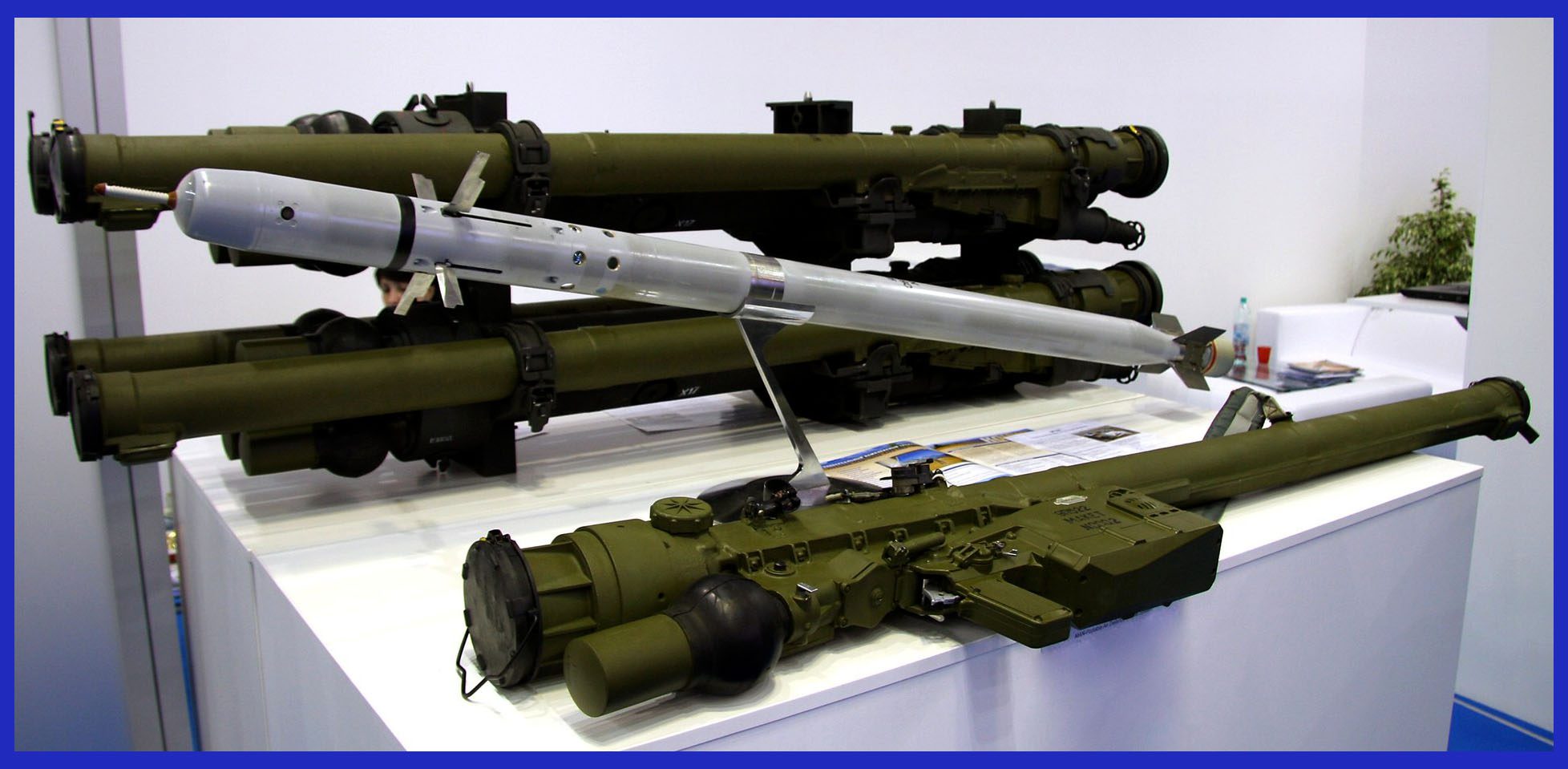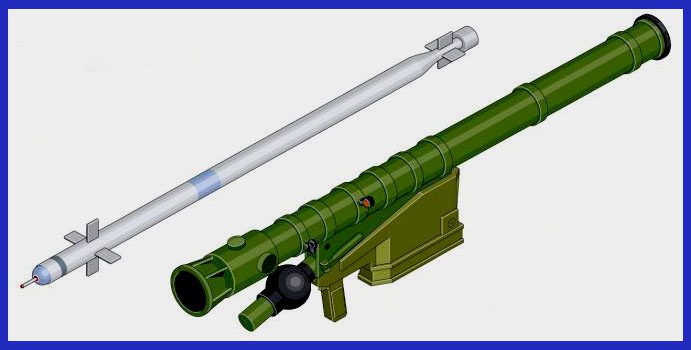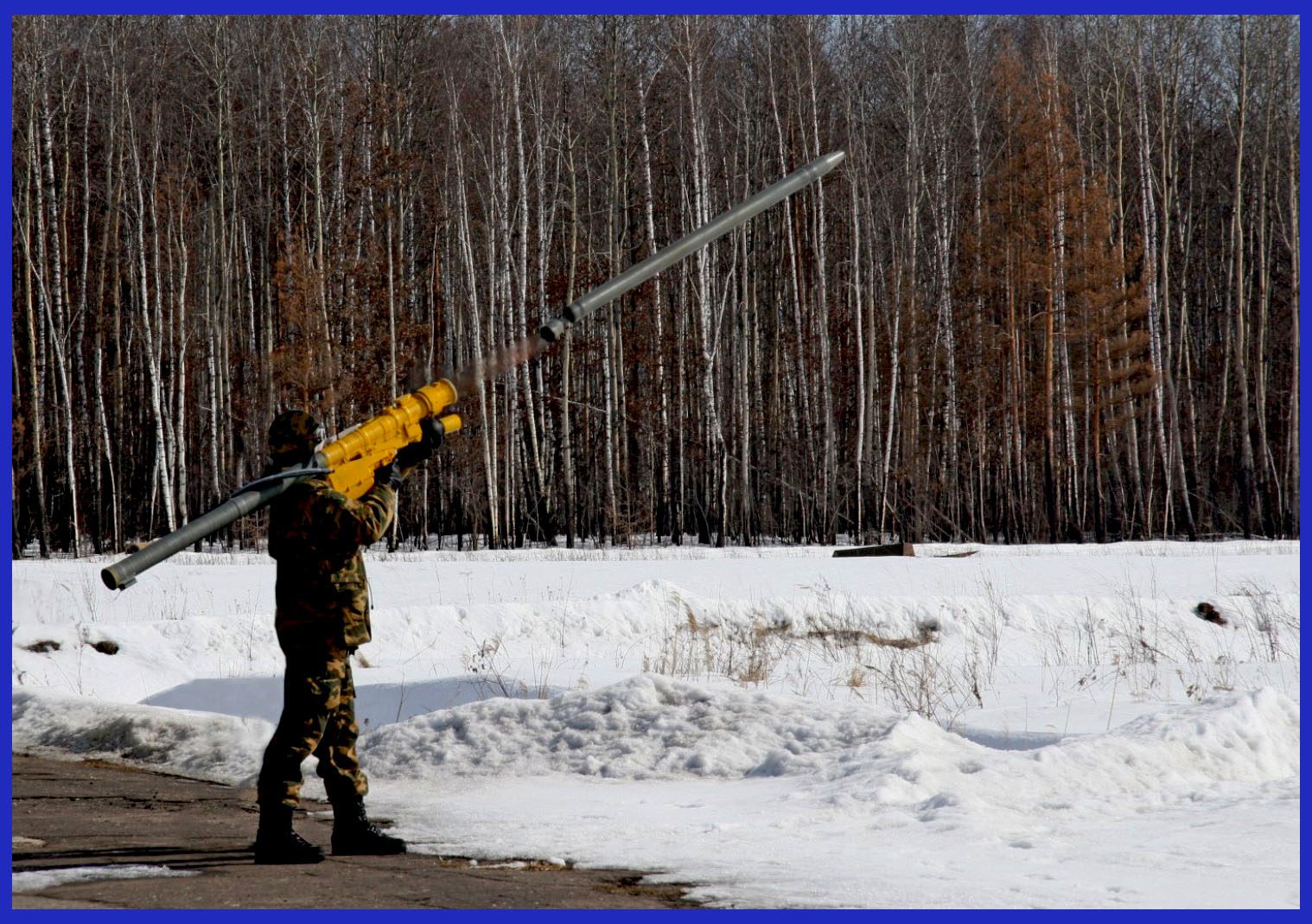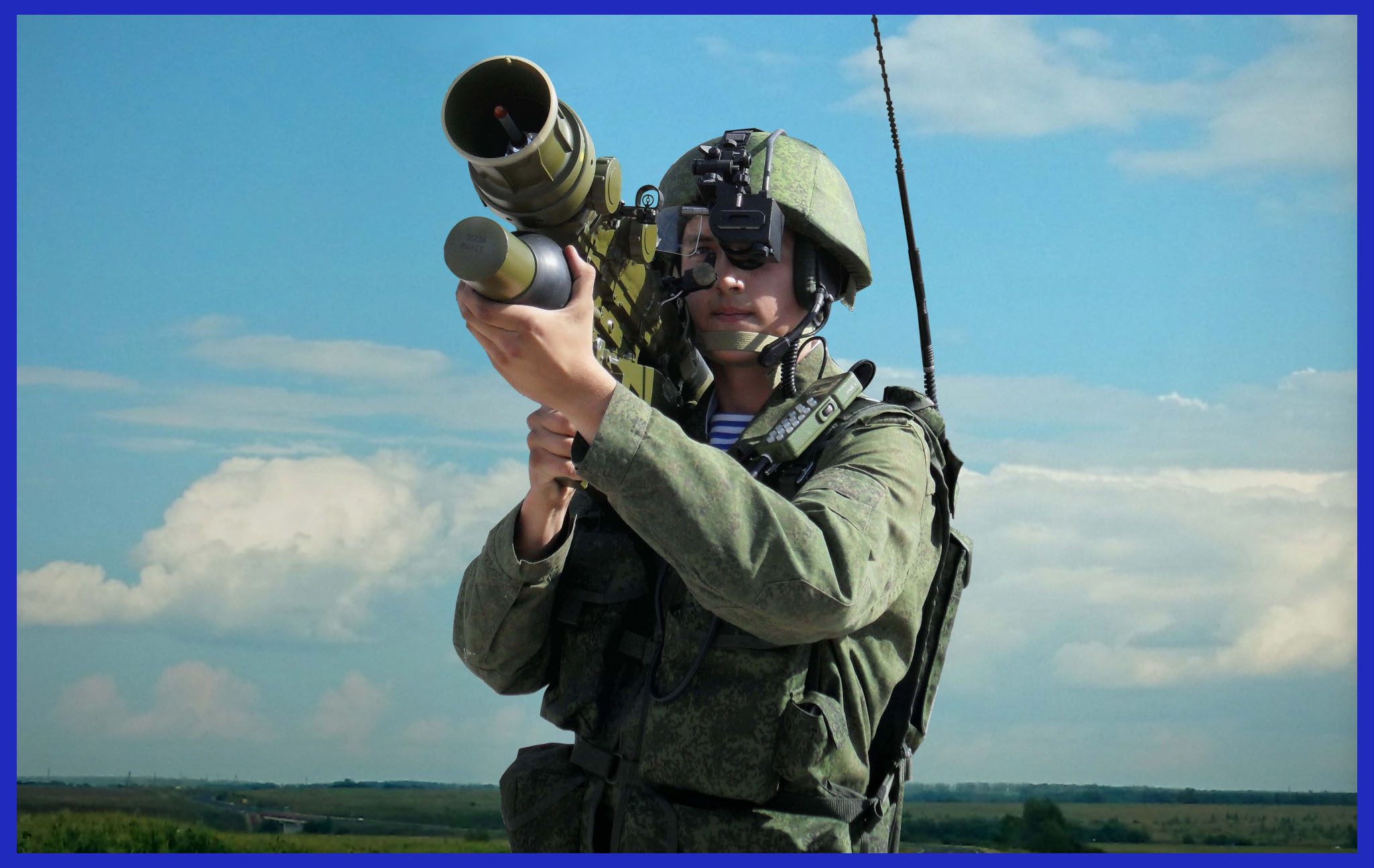Introducing the epitome of aerial defence capabilities, Unveiling the Mighty Igla and Verba Air Defence System, which first entered into service in 1981 as the “9K38 Igla” and was later introduced in its updated variant in 2004, known as the “9K338 Igla-S” with a NATO code name of SA-24 Grinch. To rival the US-origin Stinger, the Russians once again introduced an enhanced version of Igla in 2014, designated as the “9K333 Verba” with the NATO code name SA-29.
By introducing the unstoppable might and unrivalled superiority of the awe-inspiring Igla and Verba Air Defence Systems, the guardians of the sky showcase their capability to annihilate any airborne menace with relentless precision and unwavering determination. Equipped with cutting-edge technology and formidable firepower, these indomitable systems unleash an impenetrable shield.
The updated Igla and latest Verba are both man-portable air defence systems ( MANPADS ) developed by Russia. These systems are designed to engage and destroy low-flying enemy aircraft, such as helicopters, fixed-wing aircraft, and unmanned aerial vehicles ( UAVs ).
Updated, Igla-S ( SA-24 Grinch ): The Igla is a shoulder-fired surface-to-air missile system that entered service with the Russian military in 2004. It is widely used by many countries around the world. The Igla system consists of a lightweight missile launcher and infrared-homing missiles. The missiles are equipped with a passive infrared seeker head, which allows them to home in on the heat emitted by the target aircraft’s engines or other heat sources. The Igla has a range of up to 6 kilometres ( 3.7 miles ) and can engage targets flying at altitudes of up to 3.5 kilometres (2.2 miles).
Verba ( SA-29 ): The Verba is an upgraded version of the Igla system and was introduced in 2014. It features several improvements over its predecessor, including enhanced resistance to countermeasures, improved range, and higher manoeuvrability. The Verba uses an advanced multispectral optical seeker with increased resistance to various types of countermeasures, such as flares and jamming. It has a range of up to 6.5 kilometres ( 4.3 miles ) and can engage targets flying at altitudes of up to 4.5 kilometres ( 2.8 miles ).

Both the Igla and Verba systems exhibit high portability and can be operated effectively by a single operator. Typically utilized by infantry units or special forces, these systems offer short-range air defence capabilities across diverse combat scenarios. Their pivotal role lies in safeguarding ground forces from airborne threats, contributing significantly to the comprehensive air defence strategy of the armed forces that deploy them.
Exploring the History Of Igla and Verba MANPADS Systems
The saga begins with the groundbreaking Igla, an epoch-making creation that emerged in the late 1980s. From its inception, it commanded attention with its compact design and revolutionary infrared homing missiles, honed to detect and engage low-flying aircraft with unrivalled accuracy. As it swiftly found its way into the arsenals of nations worldwide, the Igla became synonymous with aerial defence prowess, safeguarding troops and territories against airborne threats.
9k310 Igla-1: also known as the SA-16 Gimlet in NATO terminology
represents a shoulder-fired surface-to-air missile system. Its development took place in the 1980s under the Soviet Union’s purview, with the purpose of replacing the earlier Strela-2 and Strela-3 MANPADS. The origins of the Igla short-range man-portable air defence system ( MANPADS ) trace back to 1972 when development commenced at the Kolomna OKB. It is important to note that the Igla is not merely an enhanced iteration of the previous Strela family ( Strela-2 and Strela-3 ), but rather an entirely novel undertaking. The primary objectives of the project involved constructing a missile with heightened countermeasure resistance and a broader engagement envelope compared to the earlier Strela series MANPADS systems.
However, complications arose during the development process, indicating that completion would require significantly more time than initially expected. Consequently, in 1978, the program bifurcated into two streams: one focusing on the continued advancement of the full-capability Igla and the other undertaking the simultaneous creation of a simplified version known as the Igla-1. The latter variant featured a less complex IR seeker, drawing inspiration from the earlier Strela-3 model. This strategic approach aimed to ensure the earlier entry into service of a version, while the full-capability iteration remained under development.

The 9K310 Igla-1 system was accepted into service in the Soviet Army on 11 March 1981. The main differences between the Igla-1 and the Strela-3 include several notable features. Firstly, the Igla-1 introduced an optional Identification Friend or Foe system to prevent inadvertent firing on friendly aircraft. Additionally, it incorporated automatic lead and superelevation capabilities, simplifying shooting and reducing the minimum firing range. The rocket used in the Igla-1 was slightly larger, resulting in reduced drag and an improved guidance system, which extended the maximum range and enhanced performance against fast and manoeuvrable targets.
The Igla-1 also achieved improved lethality on the target through a combination of delayed impact fuzing and terminal manoeuvring, designed to hit the fuselage rather than the jet nozzle. Furthermore, it included an additional charge to detonate any remaining rocket fuel upon impact. In terms of countermeasures, the Igla-1 demonstrated enhanced resistance to infrared countermeasures such as decoy flares and jamming emitters. Lastly, the seeker sensitivity of the Igla-1 was slightly improved compared to the Strela-3.
The seeker of the Igla missile system is equipped with two detectors: a cooled MWIR InSb detector responsible for target detection and an uncooled PbS SWIR detector designed for detecting infrared decoys, such as flares. The integrated logic within the system analyzes the data to determine whether the detected object is a target or a decoy. In its latest variant, Igla-S, additional detectors are reportedly positioned around the main seeker to improve resistance against pulsed IRCM (Infrared Countermeasure) devices commonly employed by helicopters.
In terms of the missile itself, the 9M313 version features a drag-reducing aerospike mounted on a tripod. It is worth noting that the 9M39 missile variant of the Igla has an aerospike directly attached to the seeker dome, resembling a needle. Interestingly, the translation of the missile’s codename, “игла” in Russian, coincidentally means “needle.” The inclusion of these drag-reducing aerospike devices helps reduce shock waves, resulting in decreased dome heating and extended range, thus explaining the derivation of the name Igla from these components.

Similar to other MANPADS, the Igla-1 and Igla systems incorporate rolling airframe missiles. These missiles rotate during flight at a speed ranging from 900 to 1,200 revolutions per minute ( rpm ). This unique design allows the missile to be steered using only a single pair of control surfaces, unlike roll-stabilized missiles that require separate control surfaces for pitch and yaw. Both the 9M313 and 9M39 missiles are equipped with a gas generator, which operates a small gas turbine responsible for generating electrical power. The generated power is utilized to move the pistons controlling the canards, which steer the missile in a bang-bang mode, employing discrete on-off actions.
Additionally, the gas generator features two exhaust tubes positioned perpendicular to the steering canards. This arrangement enables the missile to manoeuvre immediately after launch, even when the airspeed is insufficient for the canards to exert effective control. Furthermore, it has been reported that later versions of the Igla employ proportional control to drive the canards. This advancement provides enhanced precision and reduces oscillation in the missile’s flight path. According to the manufacturer, South African tests have demonstrated the Igla’s superiority over the contemporary American FIM-92A Stinger missile, which is smaller and lighter.
9K38 Igla: also known as the SA-18 Grouse In NATO terminology
The full-capability 9K38 Igla, equipped with its powerful 9M39 missile, was ultimately accepted into service in the Soviet Army in 1983. This version showcased significant advancements compared to the Igla-1. Notably, it demonstrated much-improved resistance against flares and jamming, ensuring heightened effectiveness even in challenging scenarios. The seeker of the Igla also boasted enhanced sensitivity, allowing for precise target acquisition. Additionally, the forward-hemisphere engagement capability expanded to encompass straight-approaching fighters, enabling all-aspect capability under favourable conditions.
Furthermore, the full-capability Igla offered a slightly longer range, extending its operational reach. Its rocket featured a higher-impulse, shorter-burning design, resulting in a higher peak velocity while maintaining a similar time of flight to maximum range.
For naval applications, the 9K38 Igla variant earned the NATO reporting name SA-N-10 Grouse, indicating its formidable capabilities on maritime platforms. Additionally, a notable two-barrel missile launcher called Dzhigit was developed in conjunction with the 9K38 Igla system, further enhancing its deployment options. Over the years, the Igla MANPADS has undergone several upgrades, resulting in improved performance, better countermeasures resistance, and enhanced capabilities. These upgrades have included improvements to the missile’s guidance system, warhead, and countermeasures capabilities.

9K338 Igla-S: also known as the SA-24 Grinch In NATO terminology
The newest variant, known as the 9K338 Igla-S is a substantially improved version featuring a longer range, a more sensitive seeker, improved resistance to the latest countermeasures, and a heavier warhead. According to manufacturer reports, it boasts a hit probability of 0.8–0.9. State tests were completed in December 2001, and the system entered service in 2002. Production of the series has been undertaken by the Degtyarev plant since 1 December 2004. The Igla-S features several improvements over its predecessor, enhancing its capabilities and performance. Some of these improvements include:
- Improved guidance system: The Igla-S utilizes an advanced passive infrared homing guidance system. It has a more sophisticated seeker with better sensitivity and resistance to countermeasures.
- Enhanced target engagement range: The Igla-S system boasts an extended range when compared to the original Igla, allowing it to effectively engage targets at distances of up to 6 kilometres (3.7 miles) and altitudes reaching 3.5 kilometres (2.2 miles).
- Enhanced resistance to countermeasures: The Igla-S is designed to be more resistant to various countermeasures employed by aircraft, such as flares and jamming systems. It incorporates improved algorithms and signal processing techniques to discriminate between the target and countermeasures.
- Improved warhead: The Igla-S features an upgraded warhead with Contact and grazing fuze, that is more effective against a variety of targets, including aircraft, helicopters, and UAVs.
The Igla-S ( SA-24 Grinch ) has been widely exported to numerous countries and has been used in various conflicts around the world. Its portability, effectiveness, and reliability make it a valuable asset for ground forces requiring air defence capabilities against low-flying aerial threats.
Despite the high success rate of the Igla surface-to-air missile ( SAM ) systems, Russia has once again taken a bold initiative to replace the Igla with more cutting-edge technology, specifically aimed at countering the advancements of the Stinger system. Since 2014, the Russian armed forces have been replacing the Igla with the new and advanced 9K333 Verba ( Willow ) MANPADS. The Verba boasts a range of modern features, but its primary standout is its multispectral optical seeker, which utilizes three sensors instead of the two found in the Igla-S.
This innovative design allows for cross-checking between sensors, significantly improving the system’s ability to distinguish between actual targets and decoys, while also reducing susceptibility to countermeasures such as laser devices attempting to blind the missiles.

Variants Of The Igla MANPAD System
- Igla-1 is an early production variant that features a simplified design. Referred to as the SA-16 Gimlet in Western terminology, it boasts a maximum range of 5 km and the capability to engage targets at altitudes of up to 2.5 km.
- Igla-1E serves as an export version of the system, successfully exported to 35 countries.
- Igla, designated as the SA-18 Grouse, represents the standard production variant and was officially adopted in 1983. It is currently actively utilized by more than 30 countries, including Russia.
- Igla-D is a specialized version developed specifically for Soviet airborne troops. Its launch tube can be disassembled into two separate sections, allowing for reduced dimensions during transportation.
- Igla-M serves as the naval variant tailored for deployment on naval boats. In Western classification, it is known as the SA-N-10 Grouse.
- Igla-V is primarily designed as an air-to-air version and is predominantly employed on helicopters.
- Igla-N is a variant equipped with a larger and more powerful warhead.
- Igla-S also referred to as Igla-Super, stands as an enhanced variant of the Igla system that was introduced into service with the Russian Army in 2004.
These are some of the notable variants of the Igla MANPADS. It’s worth noting that different countries may have their own designations or modifications based on their specific requirements or upgrades

The Arrival of the 9K333 Verba, NATO Code Name SA-29 Willow
The Verba represents a fourth-generation man-portable infrared homing surface-to-air missile ( SAM ) MANPADS. Its standout feature lies in the implementation of a multispectral optical seeker that incorporates three sensors: ultraviolet, near-infrared, and mid-infrared. In contrast to the two sensors found in the Igla-S system, this configuration allows for sensor cross-checking, thereby enhancing target discrimination by effectively distinguishing between legitimate targets and decoys. Furthermore, this design minimizes susceptibility to countermeasures, including laser interference aiming to impair missile functionality.
A spokesperson from KBM ( Instrument Design Bureau, also known as “Konstruktorskoye Buro Mashynostroyeniya” in Russian ) affirmed the Verba’s capability to engage both fixed- and rotary-wing aircraft, as well as emerging threats like unmanned aerial vehicles and cruise missiles. Emphasizing its proficiency, the spokesperson emphasized, “The 9K333 can proficiently engage aerial targets characterized by low infrared signatures. Moreover, the system can be paired with an external identification friend or foe [ IFF ] unit.” The Verba’s containerized 9M336 SAM holds the potential for seamless integration into both ground- and sea-based short-range air-defence ( SHORAD ) systems. Additionally, the spokesperson highlighted its adaptability, stating, “The SAM can also be effectively employed by air platforms.”
The Verba MANPADS system has been in serial production for the Russian Armed Forces, and since 2014, it has been progressively deployed to various ground forces and airborne formations. The first notable appearance of the Verba system was with the Ivanovo VDV ( Vozdushno-Desantnye Voyska / Airborne Forces ) division, following its successful completion of Army testing in the summer of 2011 and subsequent confirmation for production later that year.
Notably, the Verba MANPADS successfully passed state tests in 2011. By 2015, KBM had equipped the Russian army with three brigade sets and two divisional sets of the Verba system. In addition, four VDV units received the Verba MANPADS between 2014 and 2015. Officially, the Verba system entered service in 2015, and KBM entered into a long-term contract with the Russian Ministry of Defense for its continued supply and production. As of April 2017, a total of 10 sets had been delivered, and the number of systems reached 801 by November of the same year. Deliveries of the Verba system are ongoing.

9k333 Verba System Features:
- Multispectral Seeker: The Verba MANPADS incorporates a multispectral seeker, combining infrared ( IR ) and ultraviolet ( UV ) sensors to track and engage targets with reduced IR signatures or those deploying countermeasures.
Countermeasures Resistance: The Verba system is designed to have improved resistance to countermeasures employed by aircraft, such as flares and jamming systems.
Improved Reliability: The Verba system is reported to have enhanced reliability in complex battlefield environments.
Engagement Capability: The Verba MANPADS is capable of engaging a wide range of airborne threats, including aircraft, helicopters, and unmanned aerial vehicles ( UAVs )

Operational History Of Igla MANPAD System:
The Igla MANPADS (Man-Portable Air Defense System) has been extensively deployed and utilized in numerous conflicts worldwide. Here is an overview of its operational history:
The Igla MANPADS holds a significant operational history, having been deployed and utilized in various conflicts worldwide. Throughout its operational history, the Igla has been employed in conflicts such as the 1991 Desert Storm, the 2011 Libyan War, the Chechen Wars, the Yugoslav Wars, the Syrian Civil War, and the ongoing Russo-Ukraine War. It has been utilized by both state and non-state actors, highlighting its effectiveness and versatility in diverse combat scenarios.
The system’s capability to engage and neutralize aircraft has rendered it a valuable asset for insurgent and guerrilla forces, as well as conventional military units. The Igla MANPADS has notably proven its worth in engagements against aerial targets, including those fielded by opposing forces, thereby playing a pivotal role in the air defence strategies of various armed groups.
While specific operational details and outcomes may differ across conflicts, the Igla MANPADS consistently demonstrates its effectiveness and reliability in countering airborne threats. Its successful operational history further cements its reputation as a capable and widely employed man-portable air defence system.

Technical Specifications Of The Igla/Verba MANPAD System
- Weight: Complete one system of Igla: 17.9 kg ( 39 lb ) / Only Missile weight: 10.8 kg (24 lb) // Verba: 17.25 kg ( 38.0 lb )
- Length: 5.16 in ( 1.57 m )
- Wingspan: 6.3 in ( 160 mm )
- Diameter: 2.83 inches ( 72 mm )
- Warhead: 1.17 kg ( 2.6 lb ) / Verba: 1.5 kg ( 3.3 lb )
- Detonation: High Explosive Contact and grazing fuze
- Engine: Solid propellant rocket motor
- Range: Igla-1: 5.0 km ( 3.1 mi ) / Igla: 5.2 km ( 3.2 mi ) and Igla-S: 6.0 km ( 3.7 mi ) / Verba: 6.5 km ( 4.3 mi )
- Speed: Mach 1.9
- Guidance: Dual waveband infra-red homing
- Seeker: Passive IR/UV tracking fire and forget
- Launch Platform: MANPADS, Vehicle Mounted, Helicopters

In conclusion, the Igla MANPADS has established a remarkable operational history, serving as a reliable and effective man-portable air defence system. Demonstrating its capabilities in countering low-flying aircraft, helicopters, and unmanned aerial vehicles, it has been deployed in diverse conflicts globally.
From the Chechen Wars to the Yugoslav Wars, the Syrian Civil War, and the ongoing Russo-Ukraine war, the Igla MANPADS has found use among both state and non-state actors, highlighting its versatility in various combat scenarios. Its capacity to engage and neutralize aerial threats makes it a valuable asset for insurgent forces and conventional military units alike. Consistently proving its effectiveness, reliability, and portability, the Igla MANPADS has earned its reputation as a widely-utilized air defence system. With a robust operational track record, it plays a pivotal role in enhancing air defence capabilities and countering airborne threats.
In an evolving conflict landscape, the Igla MANPADS retains its significance in safeguarding ground forces and shaping the dynamics of aerial warfare. Its operational history cements its status as a trusted and influential weapon system.

Important Announcement for Our Valued Readers!
After an article is published, it is possible that updates or changes may have occurred beyond the time of publication. Therefore, it is important to be aware that certain information in the article might be outdated. To ensure the most accurate analysis, it is highly recommended to verify the content with the latest sources available.
However, we are dedicated to delivering outstanding articles on military products and global updates. Maintaining quality and smooth operation requires resources. Your support sustains our efforts in providing insightful content. By purchasing high-quality products through our affiliated links, you help us keep our platform alive and acquire top-notch items. Your unwavering support is invaluable and inspires us to strive further.
We welcome your suggestions and requests for more information, as we value feedback from our readers. If there’s specific defence material or equipment not covered on our site, please share your request in the comments. We’ll strive to research and provide the required information. We sincerely thank you for your unwavering interest in our website, and we eagerly anticipate hearing from you! Enjoy your reading experience!
